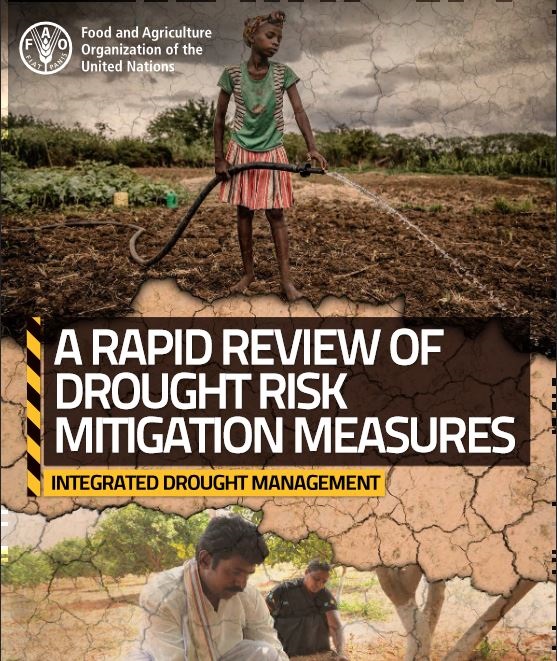
Response and mitigation
The FAO Drought portal collates tools, methodologies, publications, and best practices, with the aim to support informed decision making and promote integrated drought management in agriculture.They are organized into three pillars: monitoring and early warning, vulnerability and risk assessment, response and mitigation.
Drought mitigation, preparedness, and response comprise the appropriate measures and actions aimed at reducing ecosystems vulnerability to drought impacts. The goal of pillar 3 of integrated drought management, response and mitigation, is to determine appropriate mitigation and response actions aimed at risk reduction, the identification of appropriate triggers to phase in and phase out mitigation actions and, finally, to identify agencies, ministries or organizations to develop and implement mitigation actions.
FAO toolkit

Rapid Appraisal Procedure tool (RAP)
Rapid Appraisal Procedure (RAP) for pressurized irrigation system is a diagnostic tool developed by FAO to assess the performance of water resource, institutional management and irrigation service (hardware and software). It aims to provide users with a clear picture of problem areas. Thus, it enables the identification of the physical bottlenecks hampering the efficient water delivery and prioritize the steps needed for improvement.

AquaCrop
AquaCrop is a crop growth model developed by FAO’s Land and Water Division that addresses food security and assesses the effect of the environment and irrigation management on crop production. It simulates the yield response of herbaceous crops to water and is well suited to conditions in which water is a key limiting factor.

Sustainable Forest Management (SFM)
SFM toolbox aims to make more accessible the collective knowledge and experiences on sustainable forest management to forest managers and stakeholders. A dedicated module highlights the importance and vulnerability of dryland forests and agrosilvopastoral system.

Global Information and Early Warning System on Food and Agriculture (GIEWS)
GIEWS continuously monitors food supply and demand and other key indicators for assessing the overall food security situation in all countries of the world.

Pastoralist Knowledge Hub
The Pastoralist Knowledge Hub connects pastoralists and the main
actors working with them, to join forces and create synergies for dialogue
and pastoralist development. It relies on 3 pillars: a knowledge
repository, a network of pastoralist organizations and the facilitation of
partnerships with national and international actors.

BlueHouse-Leb
The BlueHouse-Leb application is a user-friendly mobile app that provides timely information on the irrigation needs of crops in unheated plastic greenhouses in Lebanon. The experiences show that better irrigation and agricultural practices can significantly increase the yield production and the water productivity of greenhouses, therefore, the app is expected to make farming practices more sustainable and improve the farm profitability.
FAO projects from the field
Search by
| Title | Emergency support to sustain pastoralist livelihoods affected by the drought in rural areas in Djibouti |
|---|---|
| Project Code | OSRO/DJI/102/CHA |
| Title | Emergency livelihood support to drought-affected communities in pastoral areas |
|---|---|
| Project Code | OSRO/DJI/001/CHA |
| Title | Improved food security for drought-affected households in Cunene and Huila province of Angola |
|---|---|
| Project Code | OSRO/ANG/902/CHA |
| Title | Emergency livelihood response to support drought-affected households in Cunene and Huila province |
|---|---|
| Project Code | OSRO/ANG/002/CHA |
| Title | Integrated emergency agriculture and livelihood assistance to food insecure farming families |
|---|---|
| Project Code | OSRO/AFG/908/DEN |
| Donor | Denmark |
| Title | Establishment of a Food Security Surveillance Unit and integrated support to spring seed distribution and water resources management to drought and war affected rural population |
|---|---|
| Project Code | OSRO/AFG/111/USA |
| Donor | United States of America |
| Title | Anticipatory livelihood protection to minimize drought impacts and safeguard food security in Afghanistan |
|---|---|
| Project Code | OSRO/AFG/108/CHA |
| Title | Strengthening rural livelihoods and food security program in Afghanistan |
|---|---|
| Project Code | GCP /AFG/106/USA |
| Donor | United States of America |
| Title | Providing emergency life-saving food and livelihood support to drought-affected communities in Somalia |
|---|---|
| Project Code | OSRO/SOM/211/USA |
| Donor | United States of America |
| Title | Emergency support to severely drought-affected rural populations |
|---|---|
| Project Code | OSRO/SOM/209/UK |
| Donor | United Kingdom of Great Britain and Northern Ireland |
| Title | Scaling up anticipatory action to address the threats of drought and food insecurity in Central America |
|---|---|
| Project Code | OSRO/SLM/200/EC |
| Donor | European Union |
| Title | Implementing anticipatory actions to protect agricultural-based livelihoods and food security from the impacts of drought in Honduras, Guatemala, and El Salvador |
|---|---|
| Project Code | OSRO/SLM/100/BEL |
| Donor | Belgium |
| SDG(S) |
| Title | Safeguarding livelihoods and increasing immediate food access for vulnerable rural households affected by drought |
|---|---|
| Project Code | OSRO/KEN/203/BEL |
| Donor | Belgium |
| Title | Critical interventions for drought-affected and food insecure populations in Djibouti |
|---|---|
| Project Code | OSRO/DJI/904/ITA |
| Donor | Italy |
| SDG(S) |
| Title | Mitigating the impacts of the 2021 drought on the agricultural livelihoods of smallholder farmers in southern Angola |
|---|---|
| Project Code | OSRO/ANG/100/CHA |
| Title | Improved resilience food and nutrition security of drought-affected smallholder women and men farmers |
|---|---|
| Project Code | OSRO/ZIM/802/USA |
| Donor | United States of America |


